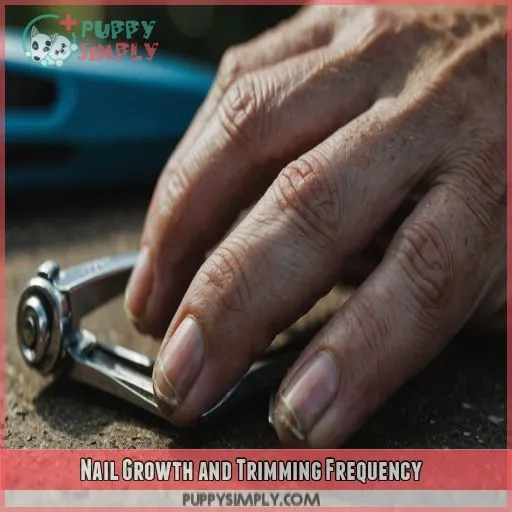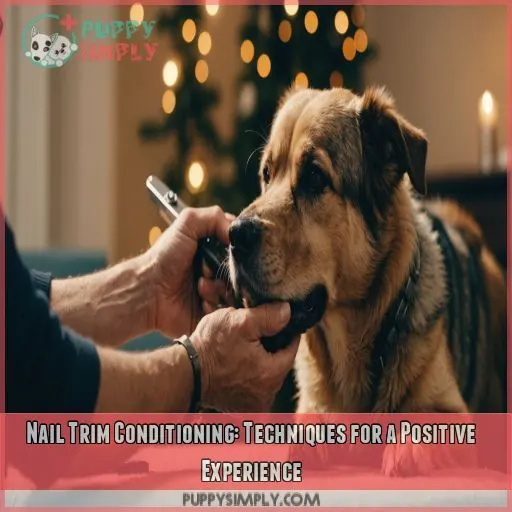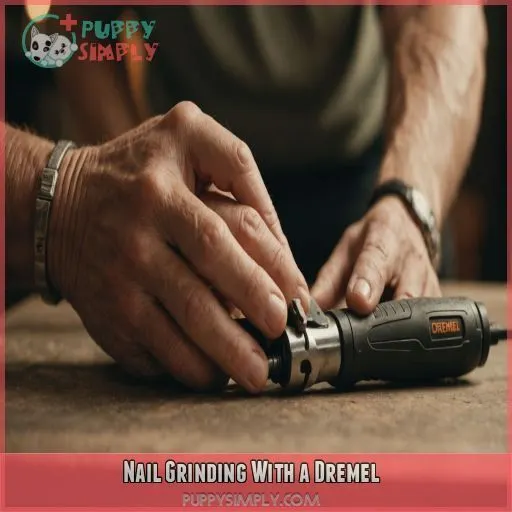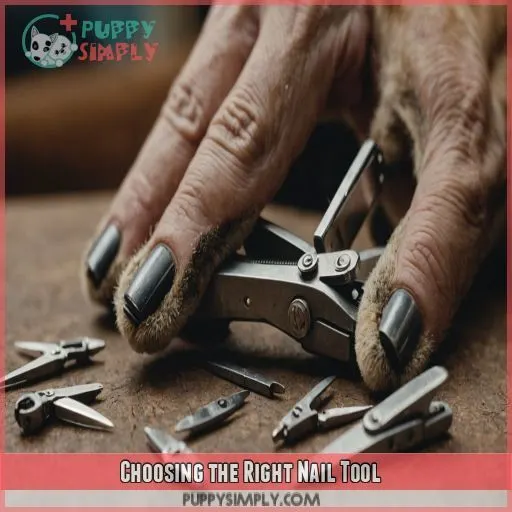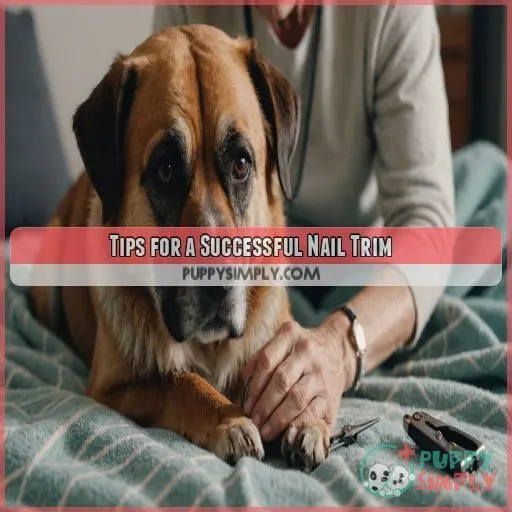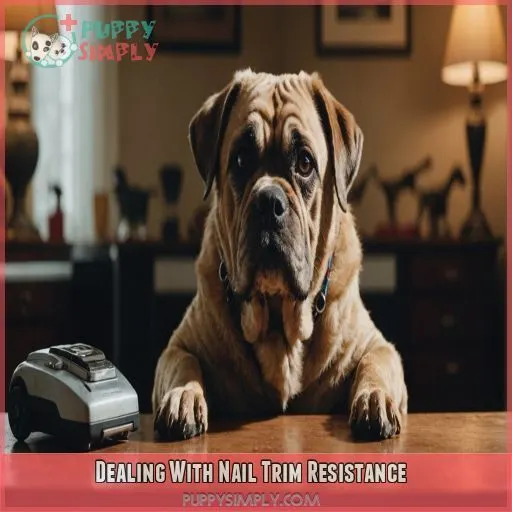This site is supported by our readers. We may earn a commission, at no cost to you, if you purchase through links.

As your dog ages, their nail growth slows down, but regular trimming is still essential to prevent joint pain, arthritis, and mobility issues.
To get started, create a calm environment, gather the right tools, and have treats ready.
Locate the quick by gently squeezing the paw, and trim a small bit at a time, following the natural shape and angle of the nail.
Remember to reward calm behavior with treats and praise.
And don’t worry, with practice, you’ll be a pro at dog nail trimming in no time – and your old furry friend will thank you for it!
Table Of Contents
- Key Takeaways
- Why Trim Senior Dog Nails?
- Nail Growth and Trimming Frequency
- Mastering Senior Dog Nail Trimming
- Desensitizing Your Dog to Nail Trimming
- Nail Trim Conditioning: Techniques for a Positive Experience
- Nail Grinding With a Dremel
- Choosing the Right Nail Tool
- Tips for a Successful Nail Trim
- Dealing With Nail Trim Resistance
- Signs Your Dog is Stressed During Nail Trims
- Frequently Asked Questions (FAQs)
- How to trim an older dog’s nails?
- How do I trim my dog’s nails when he won’t let me?
- How to cut a struggling dog’s nails?
- What happens if you wait too long to cut dog nails?
- Can I trim my senior dogs nails at home safely?
- How often should I trim my older dogs nails myself?
- What are the risks of not trimming senior dog nails regularly?
- Can nail trimming cause pain or discomfort for older dogs?
- Are there any age-related considerations for senior dog nail care?
- Conclusion
Key Takeaways
- You’ll want to trim your old dog’s nails more often as their nail growth slows down, but don’t worry, it’s not as daunting as it sounds. With practice and patience, you’ll become a pro at safely trimming those nails without stressing out your furry friend.
- Keep an eye out for signs of nail trim anxiety, such as yawning, panting, or avoiding eye contact, and take breaks when needed. Remember, it’s all about making your dog feel comfortable and secure during nail trims.
- Don’t wait too long to trim those nails, as overgrowth can lead to arthritis, infection, and painful paw problems. Trim your older dog‘s nails every 4-6 weeks, or when you notice them touching the ground, and adjust the frequency based on their activity level and surface type.
- To make nail trimming a breeze, try gradual desensitization with treats and praise, and use calming aids like pheromone diffusers or calming music to reduce canine stress. If your dog hates nail trims, consider using a nail scratch board or consulting a veterinarian or professional dog groomer for guidance.
Why Trim Senior Dog Nails?
As your furry friend ages, trimming their nails becomes even more important to prevent health issues like altered gait, joint stress, and painful nail snags. By keeping their nails trimmed, you’ll help your senior dog stay comfortable, mobile, and happy – and who doesn’t want that for their loyal companion?
Altered Gait and Joint Stress
When your senior dog’s nails get too long, their gait changes, putting stress on their joints. This can lead to joint pain, arthritis, and mobility issues. Here are 4 ways overgrown nails impact your dog’s joint health:
- Changes their stride: Long nails alter their walking pattern.
- Puts pressure on joints: Causing pain and inflammation.
- Increases arthritis risk: Already a concern for senior dogs.
- Affects exercise routine: Mobility issues can limit their activity.
Difficulty Gripping Surfaces
As your senior dog’s nails grow, they can struggle to grip surfaces, increasing the risk of slips and falls. To prevent this, regular nail trimming is really important. Here’s how different floor types affect traction:
| Floor Type | Traction Level | Safety Measures |
|---|---|---|
| Hardwood | Low | Place rugs or mats for extra grip |
| Tile | Medium | Use non-slip coatings or stickers |
| Carpet | High | Still, trim nails to prevent snagging |
| Laminate | Low | Add traction strips or rugs |
Nail Snags and Infections
As your senior dog’s nails grow, so does the risk of nail snags and infections. Keep those paws safe by trimming regularly! A simple snip can prevent painful injuries and infection, ensuring your furry friend stays happy and healthy.
Nail Growth and Trimming Frequency
As your dog ages, their nail growth slows down, but it’s still important to trim their nails regularly to prevent overgrowth. By understanding how activity level, surface type, and individual factors influence nail growth, you can determine the best trimming frequency for your senior dog’s specific needs.
Activity Level
When it comes to your senior dog’s nail growth, their activity level plays a big role. Here are 4 ways exercise impacts nail trimming frequency:
- Less exercise, more trims: Indoor dogs need more frequent trims due to less natural nail wear.
- Daily walks help: Regular walks on pavement can help wear down nails, reducing the need for trims.
- Low-impact activities matter: Gentle exercises like swimming or short walks can still impact nail growth, but less than high-impact activities.
- Arthritis impacts nail care: Dogs with arthritis may need more frequent trims due to reduced mobility and altered gait.
Surface Type
The surface type your dog spends most of their time on also impacts nail growth. For instance, dogs lounging on carpet need less frequent trims than those on hardwood, tile, or concrete, as these surfaces naturally wear down their nails.
Individual Factors
Your dog’s breed, age, health, diet, and lifestyle all play a big part in how fast their nails grow and how often you need to trim them. Think about these things:
- Breed: Some breeds, like bigger dogs, might need their nails trimmed more often.
- Age: Senior dogs might need their nails trimmed more often because their nails don’t wear down as quickly.
- Health: Dogs with certain health problems might need their trimming schedule adjusted.
Mastering Senior Dog Nail Trimming
As your dog ages, their nail care needs change, and it’s important to adapt your trimming technique to help keep them comfortable and safe. In this section, you’ll learn the steps to master senior dog nail trimming, from preparation to dealing with mistakes, so you can keep your old dog’s nails healthy and stress-free.
Preparation
Before you start trimming, create a calm environment and safe space for your dog. Gather the right tools, have treats ready, and consider enlisting a helper.
Locating the Quick
When locating the quick, gently squeeze your dog’s paw and lift a toe, looking for a darker, pinkish section within the nail – that’s the quick!
Trimming the Nail
Now that you’ve located the quick, it’s time to trim the nail. Trim a small bit at a time, following the natural shape, and angle the cut.
Positive Reinforcement
As you trim, reward your dog with treats and praise, using clicker training to create a positive association, ensuring a stress-free experience for both you.
Dealing With Mistakes
Don’t panic if you cut the quick! Stay calm, and follow these steps to minimize the damage and make nail trimming a breeze again.
- Apply pressure: Use a pet nail clotting gel or styptic powder to stop the bleeding.
- Reward calm behavior: Positive reinforcement helps your dog associate nail trimming with good things.
- Take a break: Give your dog a chance to relax and process what just happened.
- Prevent future accidents: Identify what went wrong and adjust your trimming technique to avoid cutting the quick again.
Desensitizing Your Dog to Nail Trimming
As you prepare to trim your old dog’s nails, it’s important to help them feel comfortable and relaxed around the nail-trimming process.
By taking the time to desensitize your dog to nail trimming, you can turn what might be a stressful experience into a breeze.
We’ll show you exactly how to do it with patience, positive association, and gentle practice.
Positive Association
To create a positive association with nail trimming, reward calm behavior with treats and praise. This builds trust and helps your dog connect nail trims with happy outcomes.
| Rewards | Benefits |
|---|---|
| Treats | Creates positive reinforcement |
| Praise | Boosts confidence and trust |
| Calm Environment | Reduces stress and anxiety |
Patience is Key
When desensitizing your senior dog to nail trimming, patience is key. Don’t rush the process. Go at your dog’s pace, rewarding calm behavior and watching for stress signals. With time and positive reinforcement, your dog will learn to tolerate nail trims.
Addressing Past Experiences
If your dog has had negative nail-trimming experiences, you really need to rebuild trust. Start by simply showing them the clippers, then reward calm behavior. Gradually introduce touch and trimming, always associating the process with positive reinforcement and treats.
Nail Trim Conditioning: Techniques for a Positive Experience
When you’re trimming your senior dog’s nails, it’s important to get them used to the process to avoid stress and anxiety. By using simple techniques, such as starting slow, rewarding calm behavior, and trimming just a small amount at a time, you can help your furry friend feel more at ease and even learn to enjoy the experience.
Start Slow
When introducing nail trim conditioning, start slow to avoid overwhelming your dog. Begin with small, manageable steps to build trust and confidence. Here are 4 steps to get you started:
- Let them sniff: Allow your dog to become familiar with the nail clippers or Dremel at their own pace.
- Show, don’t touch: Display the clippers or Dremel near their paw without making contact.
- Touch, don’t trim: Lightly touch the clippers or Dremel to their paw while providing treats and praise.
- Gradually increase exposure: Increase the time the clippers or Dremel are near or on their paw, rewarding calm behavior.
Reward Calm Behavior
As you trim your old dog’s nails, use treats and positive reinforcement to reward calm behavior. This gentle approach helps your furry friend associate nail trimming with a stress-free experience.
Touch the Nail
Now, gently touch the nail with the clippers, rewarding your dog for remaining calm. This small step may seem insignificant, but it’s really important in desensitizing your dog to nail trimming.
Trim a Small Amount
Now it’s time to trim a small amount of nail – start with just a tiny snip, about 1/16 inch, and reward your dog with treats and praise for staying calm.
Nail Grinding With a Dremel
You’ve mastered the art of nail trimming, and now it’s time to take it to the next level with nail grinding – a game-changer for dogs with thick or hard nails. With a Dremel, you’ll be able to smooth out those rough edges and give your old dog the comfort and care they deserve.
Desensitize to Sound
To desensitize your dog to the Dremel‘s sound, start by turning it on at a low speed, then reward calm behavior with treats and praise.
Introduce Vibration
Now that your dog is comfy with the Dremel’s sound, it’s time to introduce vibration. Here are three steps to help your dog adjust:
- Start low: Begin with the lowest vibration setting to gauge your dog’s reaction.
- Watch body language: Monitor your dog’s body language, and if they show signs of stress, stop immediately.
- Gradual exposure: Gradually increase vibration levels over time, rewarding your dog for remaining calm.
Touch the Nail With Dremel Off
Now it’s time to touch the nail with the Dremel off. Gently place the tool on your dog’s nail, rewarding calm behavior with treats.
Gradual Grinding Duration
Now that your dog is comfortable with the Dremel touching their nail, it’s time to gradually increase the grinding duration, prioritizing their comfort and sensitivity.
Hair and Safety
As you grind, gently pull back long hair to avoid tangling fur in the Dremel, an important safety precaution to prevent painful accidents and anxiety.
Choosing the Right Nail Tool
As you get ready to trim your senior dog’s nails, you need to choose the right tool for the job. It can make all the difference between a stress-free experience and a nail-trimming nightmare.
You’ve got three main options: nail scratch boards, clippers, and grinders (like Dremels), each with its own pros and cons.
Let’s figure out which one is best for you and your old buddy.
Nail Scratch Boards
In the context of nail care, a nail scratch board can be a game-changer. By encouraging your dog to scratch and file their own nails, you can reduce stress and make nail care a breeze.
- Reduces anxiety and stress associated with nail trimming
- Helps maintain healthy nail length and shape
- Provides mental stimulation and exercise for your dog
- Can be used in conjunction with other nail care tools for the best results
Clippers: Classic and Reliable
In the matter of nail clippers, you’ve got options. Here are a few:
| Clipper Type | Best For |
|---|---|
| Scissor-style | Curved nails, easy to maneuver |
| Guillotine-style | Thick nails, quick cuts |
| Nail trimmers | Precise control, small nails |
| Nail scissors | Small breeds, delicate nails |
Choose the right clippers for your old dog’s nail type, and don’t forget to keep them clean and sharp.
Grinders (Dremel): Precision With Patience
Now that we’ve covered clippers, let’s talk about grinders – specifically, Dremels. With patience and practice, you can master the art of nail shaping with a Dremel. Remember to start slow, desensitize your dog to the sound, and keep those nails tidy!
Tips for a Successful Nail Trim
You’ve made it to the fun part – actually trimming those nails! Here’s the thing: with the right approach, you can make nail trimming a breeze for both you and your senior dog, and we’re about to share some expert tips to get you started.
Just One Nail a Day!
Start with a manageable goal: trim just one nail a day! This daily nail care routine helps your senior dog gradually get comfortable with the process. Focus on a single nail, take breaks, and reward calm behavior – it’s a nail trimming schedule that works!
Keeping Your Dog Distracted
As you trim, keep your dog distracted with calming aids like pheromone diffusers, treat rewards, and toy distractions. Gentle touch and soothing, positive talk can also help calm them. Your goal is to make nail trims a breeze, not a source of stress.
Grooming Slings or Hammocks
Consider using grooming slings or hammocks to keep your dog comfortable and secure during nail trims. These canine comfort aids provide support and stability, allowing you to focus on trimming those nails without worrying about your dog’s safety.
Dealing With Nail Trim Resistance
As your dog ages, nail trim resistance can become a major challenge, making it essential to find ways to make the experience more comfortable and stress-free for both of you. If your old dog hates having their nails trimmed, don’t worry – there are plenty of strategies to help you overcome their resistance and keep their nails healthy.
Use a Nail Scratch Board
Try a nail scratch board – it’s a game-changer! These boards help your senior dog naturally wear down their nails, reducing the need for trimming.
Choose from various types, like textured surfaces or inclined planes, to suit your dog’s comfort level.
Place the board near their favorite spot, and watch them scratch away – it’s a win-win for both you and your furry friend!
What if Your Dog Hates Having Their Nails Trimmed?
If your dog hates nail trims, don’t worry, you’re not alone. It’s common for dogs to develop trim anxiety or even nail phobia. Here are some tips to help you cope:
- Gradual Desensitization: Get your dog used to the nail trimming process with small, manageable steps.
- Calming Aids: Use treats, pheromone diffusers, or calming music to reduce canine stress.
- Positive Reinforcement: Reward calm behavior with praise and treats.
- Seek Professional Help: If your dog’s nail phobia persists, consult a veterinarian or a professional dog groomer for guidance.
Signs Your Dog is Stressed During Nail Trims
Now that we’ve tackled dealing with nail trim resistance, let’s talk about recognizing when your furry friend is stressed during nail trims.
Canine body language can be subtle, but there are clear signs to look out for.
If your dog is exhibiting nail trim anxiety, they might display dog stress signals like yawning, panting, or avoiding eye contact.
They might also become restless, whine, or try to pull away.
Keep an eye out for behavioral changes, like a normally calm dog becoming agitated or aggressive.
If you notice any of these signs, it’s time to take a break and try some calming techniques.
Frequently Asked Questions (FAQs)
How to trim an older dog’s nails?
Did you know 75% of senior dogs experience nail-related health issues? To trim your older dog’s nails, gently hold their paw, isolate the nail, and snip small bits at a time, taking care not to cut the quick.
How do I trim my dog’s nails when he won’t let me?
Don’t stress! If your dog won’t let you trim their nails, try gradual desensitization with treats and praise. Introduce clippers or a Dremel gradually, rewarding calm behavior. Be patient, it’s a process!" (Source)
How to cut a struggling dog’s nails?
Trimming your struggling dog’s nails requires patience and gentle handling. Enlist a helper, secure the paw, isolate the nail, and trim small increments, rewarding calm behavior to create a positive association .
What happens if you wait too long to cut dog nails?
You’ve waited too long to cut your dog’s nails, and now they’re a hot mess! Overgrown nails can cause arthritis, infection, and painful paw problems, making every step a potentially excruciating experience for your poor pup (Source).
Can I trim my senior dogs nails at home safely?
You can safely trim your senior dog’s nails at home by following proper techniques, such as gradually introducing clippers, rewarding calm behavior, and taking small increments to avoid cutting the quick .
How often should I trim my older dogs nails myself?
Trim your older dog’s nails every 4-6 weeks, or when you notice them touching the ground. Adjust the frequency based on their activity level and surface type – less active dogs may need more frequent trims.
What are the risks of not trimming senior dog nails regularly?
If you don’t trim your senior dog’s nails regularly, you’re putting them at risk of discomfort, altered gait, joint stress, arthritis, and painful injuries from nail snags and infections – don’t let that happen!
Can nail trimming cause pain or discomfort for older dogs?
Just like the age-old adage ‘an ounce of prevention is worth a pound of cure,’ regular nail trimming can save your older dog from pain and discomfort, so you need to trim carefully to avoid cutting the quick.
Are there any age-related considerations for senior dog nail care?
As your furry friend ages, their nail care needs change. You’ll need to trim their nails more frequently, as slower nail wear can lead to overgrowth, discomfort, and health issues, so keep a close eye on those nails!
Conclusion
Ironically, trimming your old dog’s nails can be a walk in the park – if you know what you’re doing!
By mastering the art of dog nail trimming, you’ll save your furry friend from joint pain and mobility issues.
With practice and patience, you’ll become a pro at safely trimming your old dog’s nails without stress.


